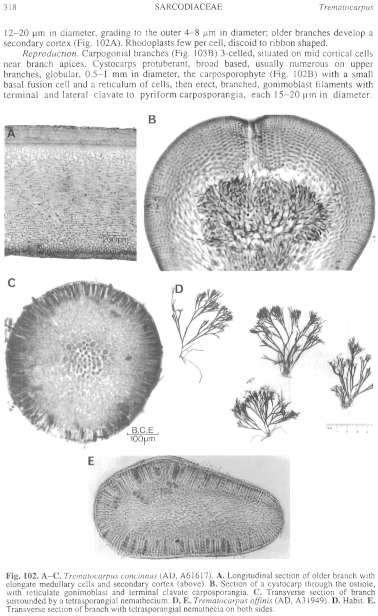|
|
|
|
|
|||||||||||
|
Electronic Flora of South Australia Species Fact Sheet
Phylum Rhodophyta – Class Florideophyceae – Order Gigartinales – Family Sarcodiaceae
Selected citations: Simons 1983: 808, figs 4,10,13.
Synonyms
Dicurella affinis J. Agardh 1852: 632; 1876: 407.
Dicurella scutellata (Hering) Papenfuss 1940: 219. Searles 1968: 73, fig. 33 (in part, see Simons 1983).
Thallus (Fig. 102D) medium red to red-brown, (3–) 5–8 cm high, subdichotomously and complanately branched at intervals of 5–20 mm, less so above with denser branching (upper branches often grazed and proliferous), branch angles 20°-60° below, narrower above, branches strongly compressed, 1–2 mm broad, linear throughout or slightly basally narrower. Holdfast crustose, 1–5 mm across, with several fronds; epilithic. Structure (Fig. 102E) of a small medullary core of longitudinally elongate cells 6–12 µm in diameter, L/D 10–20, surrounded by broader elongate-ovoid cells 12–25 µm in diameter and 50–150 µm long, decreasing to a pseudoparenchymatous cortex of ovoid cells, the inner ones 8–12 µm in diameter, grading to the outer cuboidal cells 4–6 µm in diameter and L/D 1–1.5. Rhodoplasts discoid to elongate in outer cells, becoming ribbon shaped and branched in inner cells.
Reproduction: Female plants not observed, and not described for S. African plants.
Tetrasporangial nemathecia (Fig. 102E) on one or usually both sides of upper branches, with the outer cortical cells producing anticlinal paraphyses (2–) 3 cells and 50–70 µm long, 4–7 µm in diameter, and ovoid tetrasporangia (Fig. 103E) 50–70 µm long and 14–28 µm in diameter, zonately divided.
Type from Cape Province, S. Africa (Pappe); lectotype(?) in Herb. Agardh, LD, 28695.
Distribution: West coast of S. Africa.
In Australia, only known from West I., S. Aust.
Taxonomic notes: In provision4lly recording the South African Trematocarpus affinis from southern Australia, Simons (1983) is followed as to the differences between this species and the earlier described T. flabellatus (J. Agardh) De Toni. While female plants are unknown from West I., the vegetative structure and tetrasporangia are very similar to those described by Simons.
References:
AGARDH, J.G. (1852). Species Genera et Ordines Algarum. Vol. 2, Part 2, pp. 337–720. (Gleerup: Lund.)
AGARDH, J.G. (1876). Species Genera et Ordines Algarum. Vol. 3, Part 1 - Epicrisis systematis Floridearum, pp. i-vii, 1–724. (Weigel: Leipzig.)
DE TONI, G.B. (1900). Sylloge Algarum omnium hucusque Cognitarum. Vol. 4. Florideae. Sect. 2, pp. 387–776. (Padua.)
PAPENFUSS, G.F. (1940). Notes on South African marine algae. I. Bot. Notiser 1940, 200–226.
SEARLES, R.B. (1968). Morphological studies of red algae of the order Gigartinales. Univ. Calif Pubis Bot. 43, vi + 1–86, Plates 1–12.
SIMONS, R.H. (1983). The genus Trematocarpus (Sarcodiaceae, Rhodophyta) in southern Africa and the exclusion of Sphaerococcus (Chondrus) scutellatus. Bothalia 14, 803–808.
The Marine Benthic Flora of Southern Australia Part IIIA complete list of references.
Publication:
Womersley, H.B.S. (14 January, 1994)
The Marine Benthic Flora of Southern Australia
Rhodophyta. Part IIIA, Bangiophyceae and Florideophyceae (to Gigartinales)
Reproduced with permission from The Marine Benthic Flora of Southern Australia Part IIIA 1994, by H.B.S. Womersley. Australian Biological Resources Study, Canberra. Copyright Commonwealth of Australia.
Illustrations in Womersley Part IIIA, 1994: FIGS 102D, E, 103E.

Figure 102 enlarge
Fig. 102. A–C. Trematocarpus concinnus (AD, A61617). A. Longitudinal section of older branch with elongate medullary cells and secondary cortex (above). B. Section of a cystocarp through the ostiole, with reticulate gonimoblast and terminal clavate carposporangia. C. Transverse section of branch surrounded by a tetrasporangial nemathecium. D, E. Trematocarpus affinis (AD, A31949). D. Habit. E. Transverse section of branch with tetrasporangial nemathecia on both sides.

Figure 103 enlarge
Fig. 103. A. Sarcodia marginata (AD, A24453). Transverse section of cortex with tetrasporangia. B–D. Trematocarpus concinnus (AD, A61617). B. Cortical filaments with a 3-celled carpogonial branch. C. Cortical filaments with spermatangial chains. D. Cortical filaments with tetrasporangia. E. Trematocarpus affinis (AD, A31949). Cortical filaments with tetrasporangia. F–J. Dicranema revolutum (AD, A38408). F. Branch ends with cystocarps. G. Terminal branches with tetrasporangial nemathecia. H. Longitudinal section of branch apex. I. Transverse section of branch with medullary core and large inner cortical cells. J. Cortex with deep-seated carpogonial branches. [F–J after Kraft 1977b.]

|
Email Contact: State Herbarium of South Australia |

|